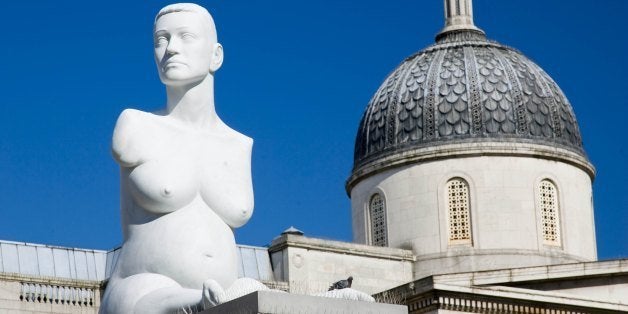
A friend of mine who is traveling in London sent me a text message of a photo she had taken of 12-foot-high, white marble statue of an armless pregnant woman with truncated legs set atop a giant pedestal in Trafalgar Square. The caption read: "Thalidomide?"
So what is this statue and what is Thalidomide? The statue my friend was looking at is an artistic representation of a woman named Alison Lapper, a disabled artist, who posed for the massive work of art that was installed in London's famed square back in 2005. As for Thalidomide, it was an anti-nausea pill prescribed to pregnant women in the 1950s and 1960s, which was found to cause a condition known as phocomelia where the limbs do not fully form. The widespread use of this drug led to the births of thousands of children with severe birth defects, countless still births and forced many mothers to have to decide whether abortion was the appropriate option for them.
One women who exemplified this struggle was Sherri Finkbine, known popularly as "Miss Sherri" who was the host of the franchised children's television show Romper Room in Phoenix, Arizona. In 1961 while her husband Bob was in London chaperoning students on a class trip he purchased a bottle of Thalidomide pills from a chemist's shop. Thalidomide was believed to be a magical cure-all for the ills of early pregnancy and by reducing the symptoms of morning sickness prevent miscarriage. In 1962 when Sherri became pregnant with her fifth child she took 36 of the pills.
Meanwhile, a German pediatrician named Widukind Lenz observed a pattern of children being born with severe deformities, such as phocomelia, and when he began documenting the cases he found that 50% of those mothers had taken Thalidomide in the first trimester of pregnancy. At the same time across the Atlantic an FDA inspector named Frances Oldham Kelsey read an open letter written by a physician to the British Medical Journal describing a similar phenomenon of babies being born with "flipper-like extremities" and immediately alerted American authorities to the risks of having Thalidomide on the market. Within months Thalidomide was pulled from shelves in most European nations and the United States. More than 10,000 children in 46 countries were believed to have been born with deformities as a consequence of Thalidomide use. The damage in the United States was small by comparison, but no less devastating to the 17 children born in America with thalidomide-associated deformities. Richardson-Merrell, the pharmaceutical company which held the patent for Thalidomide, had distributed more than 2.5 million pills to over 1,000 doctors throughout the United States on an investigational basis. The doctors, in turn, gave Thalidomide to nearly 20,000 patients, several hundred of whom were pregnant women. FDA field staff located the doctors who had been given Thalidomide and urged them to contact patients who had been given the drug. But not all of the doctors kept records of the drug's distribution. Through news releases, FDA warned women of the danger of taking the drug.
Upon learning of the negative side effects of Thalidomide Sherri Finkbine decided she wanted to have an abortion rather than risk having a severely deformed fetus. The Finkbines scheduled an abortion at the hospital though her physician warned her that they were in murky legal territory as the state of Arizona only allowed therapeutic abortions at that time and there was no reason to believe that the pregnancy posed a threat to Sherri Finkbine's health.
Sherri Finkbine contacted a friend at the Arizona Republic to tell her story so that other women who had taken or were taking Thalidomide might be made aware of the legal and ethical obstacles they potentially faced. The reporter promised Sherri Finkbine that her anonymity would be protected but because of her celebrity as a children's show host the newspaper decided to use her name.
The hospital where Finkbine planned to have the abortion did not want to risk prosecution, and when the district attorney threatened to prosecute the institution and the staff members who participated in the procedure, the hospital cancelled the surgery. The Finkbine's physician requested a court order to proceed with the abortion, arguing that it was therapeutic, but it was denied. Judge Yale McFate ruled to dismiss the physician's request because he felt he couldn't exercise authority in this matter.
The media coverage of this ordeal made Sherri Finkbine, already a minor celebrity, a major name in the news. The Finkbines began to receive death threats and the FBI had to step in to offer them protection. Bob Finkbine was suspended from his job as a high school teacher and Sherri was fired from her job as the host of "Romper Room". Desperate, the Finkbines looked outside the United States for more options.
The Finkbines initially tried to travel to Japan to obtain an abortion but were denied a visa by the Japanese Consul who did not want to be a part of the scandal. The Finkbines then flew to Sweden where abortion had been legal since the 1940s. Once they arrived in Sweden they had to plead their case in front of an abortion panel that considered the social, medical and spiritual ramifications of going forward with the procedure.
The Royal Swedish Medical Board, which consisted of ten people comprised of physicians, lawyers and a minister, granted the Finkbine's request for an abortion on August 17th, 1962. The abortion was performed "to safeguard [Sherri's] mental health" the next day on August 18th, 1962. Sherri Finkbine was at the end of her first trimester. The obstetrician who performed the abortion told the Finkbines that fetus had no legs, only one arm, indeterminate genitalia that could only be described as "an abnormal growth".
While the statue in London is of one woman, an artist named Alison Lapper, it represents the stories of so many others, including a children's television show host from over a half century ago, named Sherrie Finkbine.
